2014 FIAT BRAVO cooling
[x] Cancel search: coolingPage 45 of 275
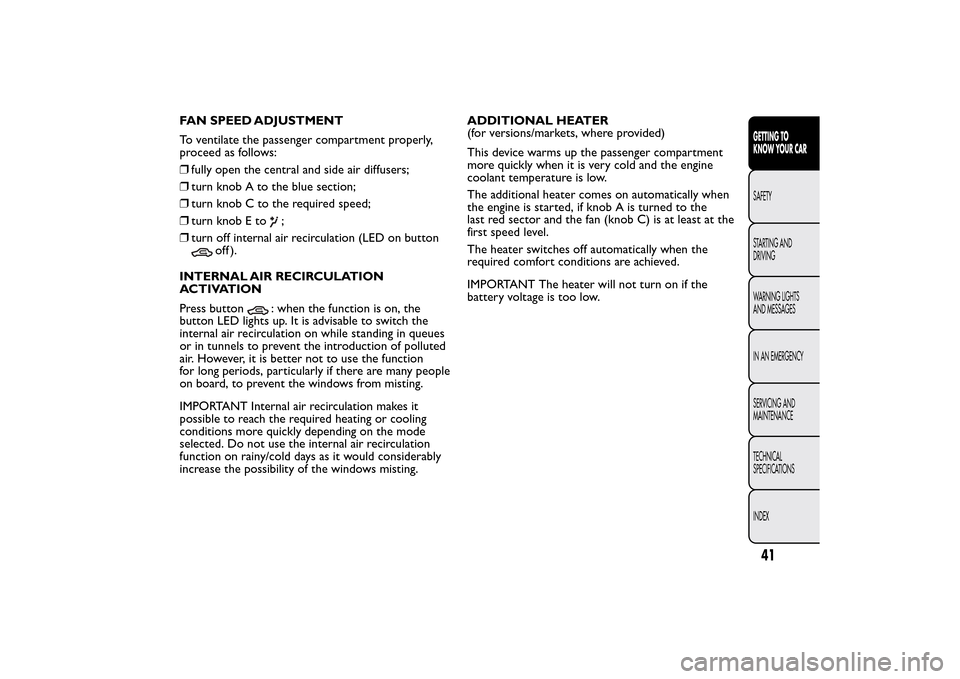
FAN SPEED ADJUSTMENT
To ventilate the passenger compartment properly,
proceed as follows:
❒fully open the central and side air diffusers;
❒turn knob A to the blue section;
❒turn knob C to the required speed;
❒turn knob E to
;
❒turn off internal air recirculation (LED on button
off ).
INTERNAL AIR RECIRCULATION
ACTIVATION
Press button
: when the function is on, the
button LED lights up. It is advisable to switch the
internal air recirculation on while standing in queues
or in tunnels to prevent the introduction of polluted
air. However, it is better not to use the function
for long periods, particularly if there are many people
on board, to prevent the windows from misting.
IMPORTANT Internal air recirculation makes it
possible to reach the required heating or cooling
conditions more quickly depending on the mode
selected. Do not use the internal air recirculation
function on rainy/cold days as it would considerably
increase the possibility of the windows misting.ADDITIONAL HEATER
(for versions/markets, where provided)
This device warms up the passenger compartment
more quickly when it is very cold and the engine
coolant temperature is low.
The additional heater comes on automatically when
the engine is started, if knob A is turned to the
last red sector and the fan (knob C) is at least at the
first speed level.
The heater switches off automatically when the
required comfort conditions are achieved.
IMPORTANT The heater will not turn on if the
battery voltage is too low.
41GETTING TO
KNOW YOUR CARSAFETY
STARTING AND
DRIVING
WARNING LIGHTS
AND MESSAGES
IN AN EMERGENCY
SERVICING AND
MAINTENANCE
TECHNICAL
SPECIFICATIONS
INDEX
Page 48 of 275
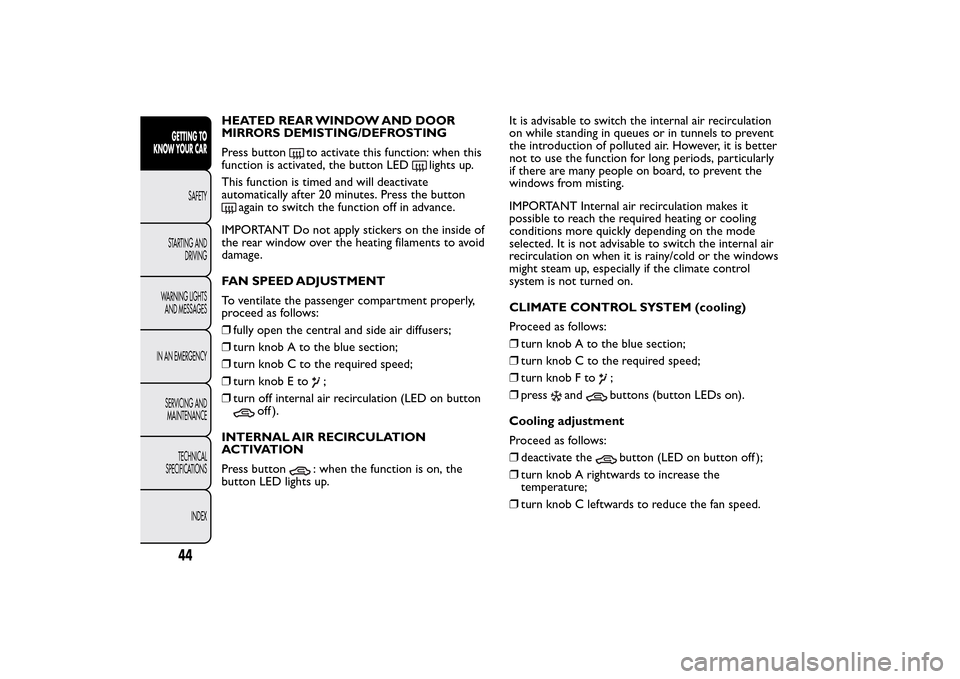
HEATED REAR WINDOW AND DOOR
MIRRORS DEMISTING/DEFROSTING
Press button
to activate this function: when this
function is activated, the button LED
lights up.
This function is timed and will deactivate
automatically after 20 minutes. Press the button
again to switch the function off in advance.
IMPORTANT Do not apply stickers on the inside of
the rear window over the heating filaments to avoid
damage.
FAN SPEED ADJUSTMENT
To ventilate the passenger compartment properly,
proceed as follows:
❒fully open the central and side air diffusers;
❒turn knob A to the blue section;
❒turn knob C to the required speed;
❒turn knob E to
;
❒turn off internal air recirculation (LED on button
off ).
INTERNAL AIR RECIRCULATION
ACTIVATION
Press button
: when the function is on, the
button LED lights up.It is advisable to switch the internal air recirculation
on while standing in queues or in tunnels to prevent
the introduction of polluted air. However, it is better
not to use the function for long periods, particularly
if there are many people on board, to prevent the
windows from misting.
IMPORTANT Internal air recirculation makes it
possible to reach the required heating or cooling
conditions more quickly depending on the mode
selected. It is not advisable to switch the internal air
recirculation on when it is rainy/cold or the windows
might steam up, especially if the climate control
system is not turned on.
CLIMATE CONTROL SYSTEM (cooling)
Proceed as follows:
❒turn knob A to the blue section;
❒turn knob C to the required speed;
❒turn knob F to
;
❒press
and
buttons (button LEDs on).
Cooling adjustment
Proceed as follows:
❒deactivate thebutton (LED on button off );
❒turn knob A rightwards to increase the
temperature;
❒turn knob C leftwards to reduce the fan speed.
44GETTING TO
KNOW YOUR CAR
SAFETY
STARTING AND
DRIVING
WARNING LIGHTS
AND MESSAGES
IN AN EMERGENCY
SERVICING AND
MAINTENANCE
TECHNICAL
SPECIFICATIONS
INDEX
Page 53 of 275
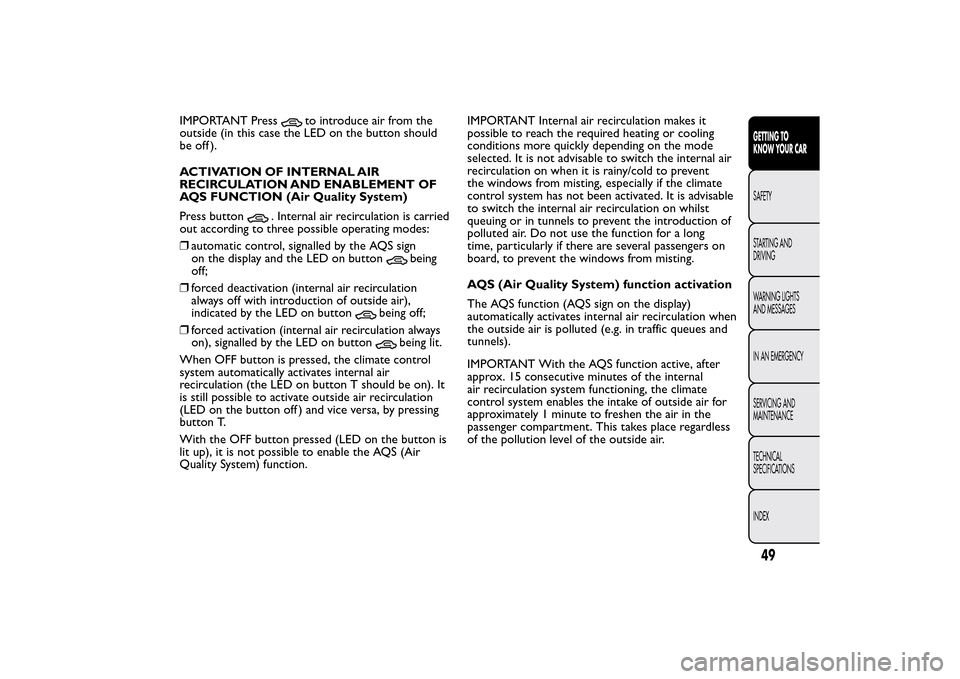
IMPORTANT Press
to introduce air from the
outside (in this case the LED on the button should
be off ).
ACTIVATION OF INTERNAL AIR
RECIRCULATION AND ENABLEMENT OF
AQS FUNCTION (Air Quality System)
Press button
. Internal air recirculation is carried
out according to three possible operating modes:
❒automatic control, signalled by the AQS sign
on the display and the LED on button
being
off;
❒forced deactivation (internal air recirculation
always off with introduction of outside air),
indicated by the LED on button
being off;
❒forced activation (internal air recirculation always
on), signalled by the LED on button
being lit.
When OFF button is pressed, the climate control
system automatically activates internal air
recirculation (the LED on button T should be on). It
is still possible to activate outside air recirculation
(LED on the button off ) and vice versa, by pressing
button T.
With the OFF button pressed (LED on the button is
lit up), it is not possible to enable the AQS (Air
Quality System) function.IMPORTANT Internal air recirculation makes it
possible to reach the required heating or cooling
conditions more quickly depending on the mode
selected. It is not advisable to switch the internal air
recirculation on when it is rainy/cold to prevent
the windows from misting, especially if the climate
control system has not been activated. It is advisable
to switch the internal air recirculation on whilst
queuing or in tunnels to prevent the introduction of
polluted air. Do not use the function for a long
time, particularly if there are several passengers on
board, to prevent the windows from misting.
AQS (Air Quality System) function activation
The AQS function (AQS sign on the display)
automatically activates internal air recirculation when
the outside air is polluted (e.g. in traffic queues and
tunnels).
IMPORTANT With the AQS function active, after
approx. 15 consecutive minutes of the internal
air recirculation system functioning, the climate
control system enables the intake of outside air for
approximately 1 minute to freshen the air in the
passenger compartment. This takes place regardless
of the pollution level of the outside air.
49GETTING TO
KNOW YOUR CARSAFETY
STARTING AND
DRIVING
WARNING LIGHTS
AND MESSAGES
IN AN EMERGENCY
SERVICING AND
MAINTENANCE
TECHNICAL
SPECIFICATIONS
INDEX
Page 149 of 275

CAR INACTIVITYIf the car is to be left inactive for longer than a
month, the following precautions should be
observed:
❒park the car in covered, dry and if possible
well-ventilated premises and slightly open
the windows;
❒engage a gear and disengage the handbrake;
❒disconnect the negative battery terminal and check
charge (see paragraph “Battery - Charge and
electrolyte level check” in chapter “Maintenance
and care”);
❒clean and protect the painted parts using
protective wax;
❒clean and protect the shiny metal parts using
special compounds available commercially;
❒sprinkle talcum powder on the rubber windscreen
and rear window wiper blades and lift them off the
glass;❒cover the car with a cloth or perforated plastic
sheet. Do not use sheets of non-perforated plastic
as they do not allow moisture on the car body
to evaporate;
❒inflate tyres to +0.5 bar above the standard
specified pressure and check it at intervals;
❒do not drain the engine cooling system.
IMPORTANT Where relevant, switch off the car
alarm with the remote control.
145GETTING TO KNOW
YOUR CAR
SAFETYSTARTING AND
DRIVINGWARNING LIGHTS
AND MESSAGES
IN AN EMERGENCY
SERVICING AND
MAINTENANCE
TECHNICAL
SPECIFICATIONS
INDEX
Page 198 of 275
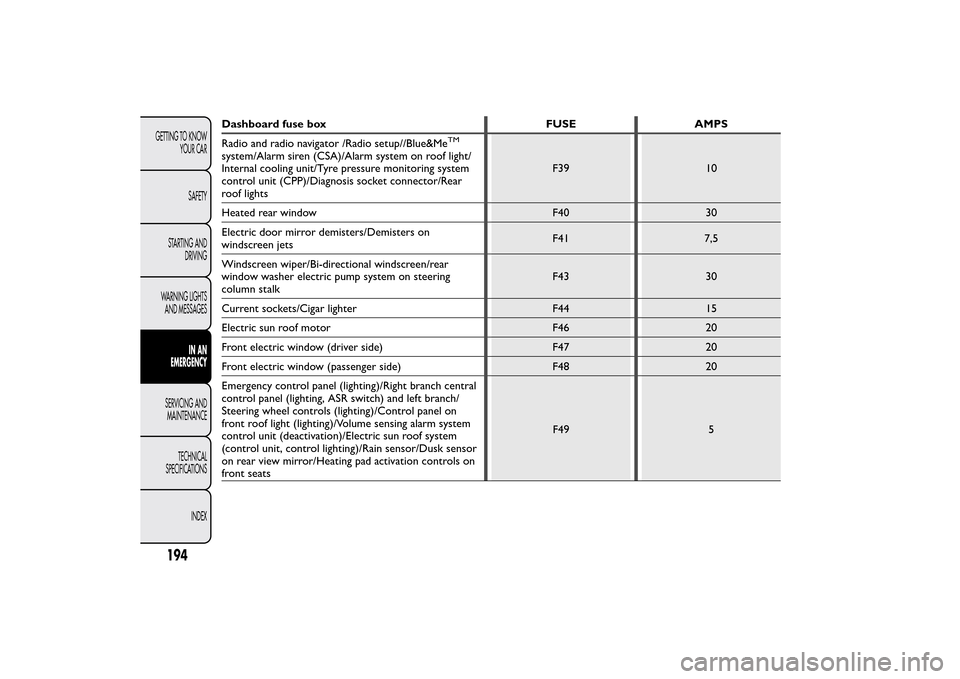
Dashboard fuse box FUSE AMPS
Radio and radio navigator /Radio setup//Blue&Me
TM
system/Alarm siren (CSA)/Alarm system on roof light/
Internal cooling unit/Tyre pressure monitoring system
control unit (CPP)/Diagnosis socket connector/Rear
roof lightsF39 10
Heated rear window F40 30
Electric door mirror demisters/Demisters on
windscreen jetsF41 7,5
Windscreen wiper/Bi-directional windscreen/rear
window washer electric pump system on steering
column stalkF43 30
Current sockets/Cigar lighter F44 15
Electric sun roof motor F46 20
Front electric window (driver side) F47 20
Front electric window (passenger side) F48 20
Emergency control panel (lighting)/Right branch central
control panel (lighting, ASR switch) and left branch/
Steering wheel controls (lighting)/Control panel on
front roof light (lighting)/Volume sensing alarm system
control unit (deactivation)/Electric sun roof system
(control unit, control lighting)/Rain sensor/Dusk sensor
on rear view mirror/Heating pad activation controls on
front seatsF49 5
194GETTING TO KNOW
YOUR CAR
SAFETY
STARTING AND
DRIVING
WARNING LIGHTS
AND MESSAGES
IN AN
EMERGENCY
SERVICING AND
MAINTENANCE
TECHNICAL
SPECIFICATIONS
INDEX
Page 199 of 275
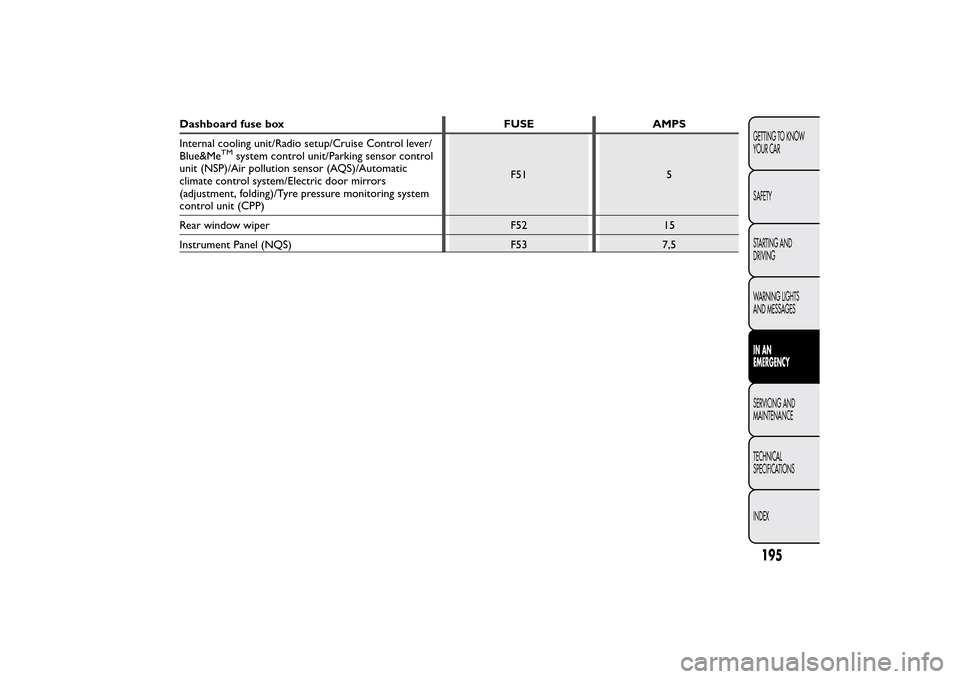
Dashboard fuse box FUSE AMPS
Internal cooling unit/Radio setup/Cruise Control lever/
Blue&Me
TM
system control unit/Parking sensor control
unit (NSP)/Air pollution sensor (AQS)/Automatic
climate control system/Electric door mirrors
(adjustment, folding)/Tyre pressure monitoring system
control unit (CPP)F51 5
Rear window wiper F52 15
Instrument Panel (NQS) F53 7,5
195GETTING TO KNOW
YOUR CAR
SAFETY
STARTING AND
DRIVING
WARNING LIGHTS
AND MESSAGESIN AN
EMERGENCYSERVICING AND
MAINTENANCE
TECHNICAL
SPECIFICATIONS
INDEX
Page 207 of 275

SCHEDULED SERVICING PLANThousands of miles 21 42 63 84 105
Thousands of km 35 70 105 140 175
Months 24 48 72 96 120
Check tyre condition/wear and adjust pressure, if necessary●●●●●
Check operation of lighting system (headlights, direction indicators, hazard
warning lights, luggage compartment, passenger compartment, glove
compartment, instrument panel warning lights, etc.)●●●●●
Check operation of windscreen washer system and adjust jets if necessary●●●●●
Check windscreen/rear window wiper blades position/wear●●●●●
Check condition and wear of front disc brake pads and operation of pad wear
indicator●●●●●
Check condition and wear of rear disc brake pads●●●●●
Visually inspect condition of: exterior bodywork, underbody protection, rigid
and flexible pipe sections (exhaust, fuel system, braking system), rubber
elements (boots, sleeves, bushes, etc.)●●●●●
Check cleanliness of bonnet and luggage compartment locks, cleanliness and
lubrication of linkages●●●●●
Check and, if necessary, top up fluid levels (brakes/hydraulic clutch, windscreen
washer, battery, engine cooling, etc.)●●●●●
Check handbrake lever travel and adjust, if required●●●●●
Visually inspect conditions of the accessory drive belt/s●●
Check battery charge status and possibly recharge●●●●●
Check emissions/fumes●●●●●
203GETTING TO KNOW
YOUR CAR
SAFETY
STARTING AND
DRIVING
WARNING LIGHTS
AND MESSAGES
IN AN EMERGENCYSERVICING AND
MAINTENANCETECHNICAL
SPECIFICATIONS
INDEX
Page 215 of 275

WASHER FLUID FOR WINDSCREEN/
REAR WINDOW/HEADLIGHTS
If the level is too low, raise reservoir cap E (see
previous pages) and add the fluid described in the
chapter "Technical Specifications".
WARNING
Do not travel with the windscreen
washer reservoir empty: the windscreen
washer is essential for improving visibility. Some
commercial windscreen washer additives are
flammable.The engine compartment contains
hot components which may set it on fire.ENGINE COOLANT
The coolant level must be checked when the engine
is cold and must range between the MIN and MAX
marks on the reservoir.
If the level is too low, undo reservoir cap F (see
previous pages) and add the fluid described in the
chapter "Technical Specifications".
PARAFLU
UP
antifreeze is used in the
engine cooling system. Use the same fluid
as in the cooling system when topping
up. PARAFLU
UP
cannot be mixed with any other
type of fluid. If this happens, do not start the
engine; contact a Fiat Dealership.
WARNING
The cooling system is pressurised. If
necessary, replace the cap with another
of equivalent quality and the same
specifications as the original, otherwise the
efficiency of the system may be adversely
affected. Do not remove the reservoir cap when
the engine is hot : you risk scalding yourself.
211GETTING TO KNOW
YOUR CAR
SAFETY
STARTING AND
DRIVING
WARNING LIGHTS
AND MESSAGES
IN AN EMERGENCYSERVICING AND
MAINTENANCETECHNICAL
SPECIFICATIONS
INDEX